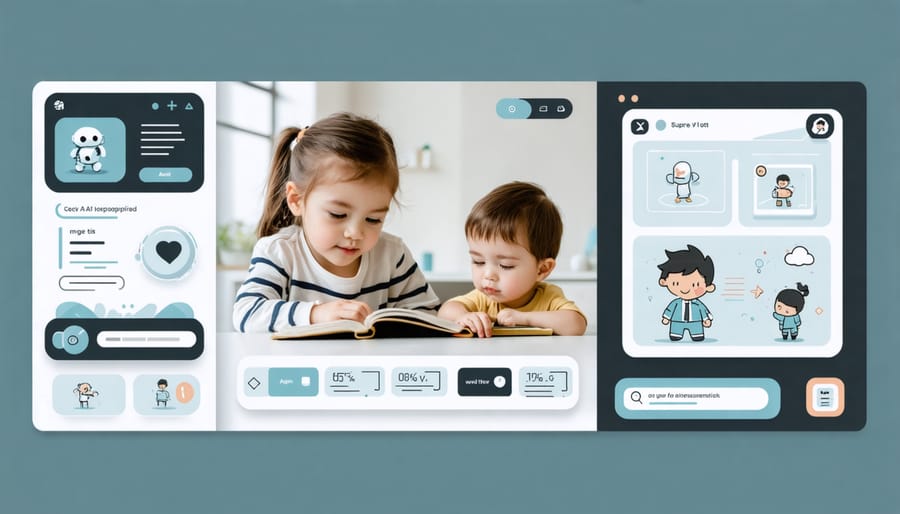Artificial intelligence is revolutionizing how our children learn, making education more personalized, engaging, and effective than ever before. As parents and educators navigate the rapidly evolving landscape of cognitive development stages, AI educational tools are emerging as powerful allies in supporting children’s academic growth and emotional well-being.
From adaptive learning platforms that adjust to each student’s pace to interactive storytelling apps that spark creativity, these digital innovations are transforming traditional teaching methods into dynamic, personalized learning experiences. Research shows that well-implemented AI tools can improve student engagement by 55% and learning outcomes by up to 40%, while simultaneously reducing teacher workload and providing valuable insights into student progress.
However, the key to success lies not just in adopting these tools, but in choosing age-appropriate solutions that complement human instruction rather than replace it. As we explore the intersection of technology and education, we’ll discover how to harness AI’s potential while maintaining the essential human connection that forms the foundation of effective learning.
This comprehensive guide will help you navigate the world of educational AI tools, ensuring you can make informed decisions that support both academic excellence and emotional development in young learners.
How AI Educational Tools Support Brain Development
Personalized Learning Pathways
One of the most remarkable features of AI-powered educational tools is their ability to create truly personalized learning experiences. These systems observe how each student learns, identifying their strengths, challenges, and preferred learning styles. For example, if a child excels in visual learning but struggles with text-based instruction, the AI adjusts to provide more diagrams, videos, and interactive graphics.
The technology continuously monitors progress, automatically adjusting the difficulty level and pace of lessons. When a student masters a concept quickly, the system advances them to more challenging material. Conversely, if they’re finding something difficult, it provides additional practice and breaks complex topics into smaller, more manageable pieces.
Many AI learning platforms also factor in emotional states and engagement levels. They can detect when a student is becoming frustrated or losing focus, automatically switching to different teaching methods or suggesting short breaks. This adaptive approach helps maintain motivation and prevents learning fatigue, creating a more positive educational experience that builds confidence alongside knowledge.
Parents and teachers receive detailed insights about learning patterns, helping them provide targeted support where it’s needed most.

Real-time Feedback and Assessment
Real-time feedback has revolutionized how students learn and grow in today’s digital classroom. When children receive immediate responses to their work, they’re more likely to stay engaged and maintain their enthusiasm for learning. These AI-powered assessment tools can instantly identify areas where a student might be struggling and offer personalized guidance, making learning feel more like a supportive conversation than a traditional test.
For example, when solving math problems, students receive instant explanations for incorrect answers, helping them understand their mistakes while the concept is still fresh in their minds. This immediate feedback loop reduces frustration and builds confidence, as children don’t have to wait days or weeks to know if they’re on the right track.
Teachers have noticed that real-time assessment tools help create a more positive learning environment. As one elementary school teacher shares, “When students get immediate feedback, they’re more willing to try again and learn from their mistakes. The instant encouragement keeps them motivated and reduces anxiety about getting things wrong.”
These tools also help parents stay informed about their child’s progress, allowing them to provide timely support when needed.

Safe and Effective AI Tools for Different Age Groups
Early Childhood (Ages 3-7)
During the crucial early years of development, AI educational tools can provide engaging ways for young children to build essential skills through play-based learning. Popular platforms like ABC Mouse and Starfall use adaptive AI technology to adjust difficulty levels based on each child’s progress, making learning both challenging and enjoyable.
Interactive storytelling apps powered by AI help develop language and literacy skills by reading along with children and encouraging them to participate in the narrative. These tools often include colorful animations and sound effects that maintain young learners’ interest while building vocabulary and comprehension.
For mathematical foundations, apps like Prodigy Math Game use AI to create personalized learning paths that introduce numbers, counting, and basic operations through fun adventures and puzzles. The technology monitors each child’s understanding and provides extra practice in areas where they need support.
Creative thinking tools like Osmo combine physical objects with AI-powered digital experiences, allowing children to experiment with shapes, colors, and patterns while developing fine motor skills. These hybrid learning experiences help bridge the gap between digital and hands-on learning.
Parents and educators should look for tools that limit screen time and incorporate movement-based activities. The best AI educational tools for this age group encourage exploration, celebrate mistakes as learning opportunities, and provide positive reinforcement that builds confidence in young learners.
School Age (Ages 8-12)
During the school-age years, AI educational tools become powerful allies in supporting academic growth and critical thinking development. These tools adapt to each child’s learning pace, making subjects like math, science, and language arts more engaging and personalized.
Popular platforms like Khan Academy now incorporate AI features that identify knowledge gaps and suggest targeted practice exercises. For students struggling with specific concepts, AI-powered tutoring apps like CogniFit and Photomath provide step-by-step explanations and real-time feedback, boosting confidence and understanding.
Many teachers have found success using Duolingo’s AI language learning system, which adjusts difficulty levels based on student performance. This adaptive approach helps maintain motivation while preventing frustration. Similarly, coding platforms like Scratch Jr use AI to guide children through programming concepts at their own pace.
For developing critical thinking skills, tools like BrainPOP’s AI features encourage students to analyze information and solve complex problems. These platforms create safe spaces for intellectual exploration while monitoring progress and suggesting new challenges.
Remember that while AI tools are valuable resources, they work best when balanced with traditional learning methods and human interaction. Parents and teachers should monitor usage and ensure these tools complement, rather than replace, core educational experiences. The goal is to harness AI’s capabilities while maintaining meaningful connections and discussions in the learning process.
Supporting Your Child’s Mental Health with AI Learning
Reducing Learning Anxiety
AI educational tools are revolutionizing the way students approach learning by creating a supportive, judgment-free environment that helps in managing learning anxiety. Unlike traditional classroom settings, AI tools provide a private space where students can make mistakes, ask questions repeatedly, and learn at their own pace without fear of peer criticism or negative feedback.
These digital learning companions offer gentle encouragement and personalized support, adapting to each student’s comfort level and learning style. For instance, when a child struggles with a math problem, AI tools can break down complex concepts into smaller, more manageable steps, offering immediate assistance without any signs of frustration or impatience.
Many parents report that their children feel more confident trying new subjects through AI platforms because they know they won’t be judged for wrong answers. The technology maintains a consistently calm and supportive presence, helping students build self-confidence while developing their academic skills. This emotional safety net is particularly valuable for children who may feel anxious about raising their hands in class or speaking up during group discussions.
Building Learning Confidence
AI educational tools excel at building learning confidence through personalized achievement paths that adapt to each student’s unique pace and style. When children experience success at their own level, they develop a stronger sense of self-efficacy and enthusiasm for learning.
These tools create what educators call “just-right challenges” – tasks that are neither too easy nor too difficult. For instance, if a student struggles with multiplication, the AI system might break down complex problems into smaller, manageable steps, offering encouragement and immediate feedback along the way.
Parents and teachers report that children who use adaptive learning technologies show increased willingness to tackle challenging subjects. As one elementary school teacher shares, “I’ve seen students who previously avoided math now eagerly engaging with problems because they know they’ll get the support they need.”
The key is consistent progress tracking and celebration of small wins. AI tools help visualize learning journeys through progress bars, achievement badges, and personalized milestone celebrations, making the learning process more engaging and less intimidating. This approach helps build resilient learners who view challenges as opportunities rather than obstacles.

Parent’s Guide to Implementing AI Learning Tools
Introducing AI learning tools to your child’s educational journey requires a thoughtful and balanced approach. Start by having an open conversation with your child about these new tools, explaining how they can make learning more engaging and personalized. It’s essential to choose age-appropriate applications and begin with short, supervised sessions to observe how your child interacts with the technology.
Creating a structured schedule for AI tool usage helps maintain a healthy balance between digital and traditional learning methods. Consider setting specific times during homework or study periods when these tools can be most beneficial. Remember to regularly review your child’s progress and adjust the schedule as needed.
Safety should always be a priority, and setting up parental controls is crucial before introducing any new AI learning tool. Monitor content accessibility and screen time limits to ensure a safe learning environment. Many educational AI platforms offer parent dashboards where you can track your child’s activities and progress.
Collaborate with your child’s teachers to ensure the AI tools complement classroom learning. This partnership can help identify which applications best support your child’s curriculum and learning style. Remember to celebrate your child’s achievements and maintain regular check-ins about their experience with these tools, addressing any concerns or challenges they might face.
Stay involved in your child’s AI learning journey by occasionally participating in activities together, making it a shared experience that strengthens both their educational growth and your bond.
AI educational tools offer exciting opportunities to enhance learning experiences while supporting children’s cognitive development. When thoughtfully implemented, these tools can provide personalized learning paths, immediate feedback, and engaging interactive content that keeps students motivated. However, it’s essential to maintain a balanced approach that combines technological innovation with traditional teaching methods and human connection.
Remember that AI tools should complement, not replace, the invaluable role of teachers and parents in education. By carefully selecting age-appropriate applications, monitoring usage, and maintaining open communication about digital learning experiences, we can help children benefit from these advances while protecting their emotional well-being. The future of education lies in finding the right balance between innovative technology and nurturing human relationships that foster both academic success and healthy development.



